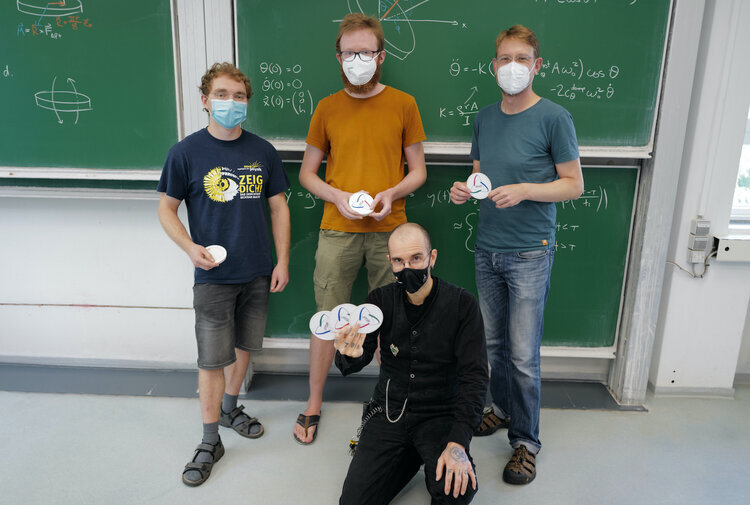2003 AIR: Hitler´s Skull & Teeth
Source: Annals of Improbable Research 9(2): 9-10 (2003), click for .pdf
Hitler´s Skull & Teeth
I am a true nerd I guess: Spectacles, checkered pattern shirt, no radio, no TV — a forensic entomologist by profession. So when National Geographic Channel called and asked the allegedly "most famous forensic biologist on earth" (my editorial house's claim, definitely not mine) to join into an investigation on the remains of Adolf Hitler, I nerdily thought it just a theoretical enterprise, and said yes. As with many people born in Germany long after World War II, I, to a large extent, regarded Hitler as a very bad, extremely cruel joke against mankind. I had never quite thought of Hitler as a real, physically present person. I have no fascination of any sort with the guy. Just look at him (see Figure 1) — he was a jerk amongst jerks.
What is more, most Germans do not know that Hitler's corpse was destroyed only around the year 1970 — except for a piece of skull bone, and his teeth. Since 1945, the charred body had rested secretly in Eastern German soil, in the city of Magdeburg. Yuri Andropov, then head of the KGB, later head of the Soviet Union, ordered his agents in 1970 to finally — and this time really — burn up the body. Afterwards, the ashes were spread into a nearby river. The grapevine made this ultra-secret action locally known in Eastern Germany, but it was not at all in Western Germany (which is where I was living).
Weird fact no. 1: Hitler had ordered his body to be burned to ashes. In the last days of the war in Berlin, it was, however, a little difficult to find enough fuel to burn a human corpse. Therefore, one of the last orders of the crazy man was to obtain burning liquid. Hitler's driver could only obtain around 180 liters (about 50 U.S. gallons) so that after burning, Hitler's body, though severely blackened on the outside, still had its inner organs and bones intact ("intact" in forensic lingo, I mean). Even after death, post-card-painter-gone-nuts Adolf Hitler was a loser.
And so, literally, I had stumbled into a most bizarre forensic investigation. Since no high-resolution color photographs of the remains existed, National Geographic Channel bribed me a way into the archives, and also put me in touch with the few still-living eyewitnesses of the events of April 30 (Hitler's suicide) to May 8, 1945 (the final day of Word War II). I say "stumbled" because the first archive I went into (the State Archive) was not only covered in thick layers of dust, but was also filled with piles of cardboard boxes, sheets, and drawers gone wild (see Figure 2). When the archivist opened the box containing Hitler's skull piece, I nearly cracked up laughing: She had stored the thing in a floppy disk container, most likely because of the nice little plastic lock that is attached to the front of the box (see Figure 3).
Weird fact no. 2: Hitler's head rests, not in peace, but on two sheets of Kleenex in a floppy disk storage case.
The actual identification of Hitler's remains (and therefore the confirmation of his death based on physical evidence) was published in 1972. It was performed by comparing the teeth of the remains to the dental schemata drawn by Hitler's dentist. The teeth are not located in the State Archives, where one might expect them to be, but in the former KGB archive, which is in a different part of Moscow. The interior design of the KGB building looks exactly like in a James Bond movie: Light blue curtains, cream-color telephones without dials, and numerous brown 'n cozy armchairs (see Figure 4).
The teeth are stored inside of large overseas travel suitcases, packed together with Hitler's uniform and the original files of the death investigation. The reports of Hitler's dentist, Blaschke (who had formerly studied in the U.S.), and other witnesses clearly show that the teeth in that little cigar box must indeed be the Fuehrer's (see Figure 5). The details all accord. For example, a most massive metal bridge that is well preserved can also be seen on X-rays taken of Hitler's head in 1944. (He had complained about headaches after an attempted assassination, that is why the X rays were taken.)
In the 1990s, my colleague Michel Perrier, a university odontologist from Lausanne with profound knowledge of, and practice (some would say obsession) in, forensic odontology, went a step further and compared original movie footage in which Hitler shows his teeth whilst grimacing during speeches, or smirking (see Figure 1) with the teeth from the archive. He could identify shiny structures (metal artifacts) on the sides, and severe paradontosis of the lower front teeth in the movies as well as in the actual teeth.
Weird fact no. 3: Hitler's teeth were so bad — and uniquely bad — that his teeth alone made it possible to identify his corpse. The state of his teeth might also explain why everybody complained about Hitler's oral malodor.
His mistress Eva Braun's teeth, by the way, are kept in an even smaller, even crappier cigar box than the one containing Hitler's teeth.
Did I feel the cold touch of history when examining Hitler's remains (see Figure 6)? No. But being a nerd, I believe that it is very appropriate to see the madman's remains in pieces, spread in different archives over Moscow, and basically forgotten under dust.





